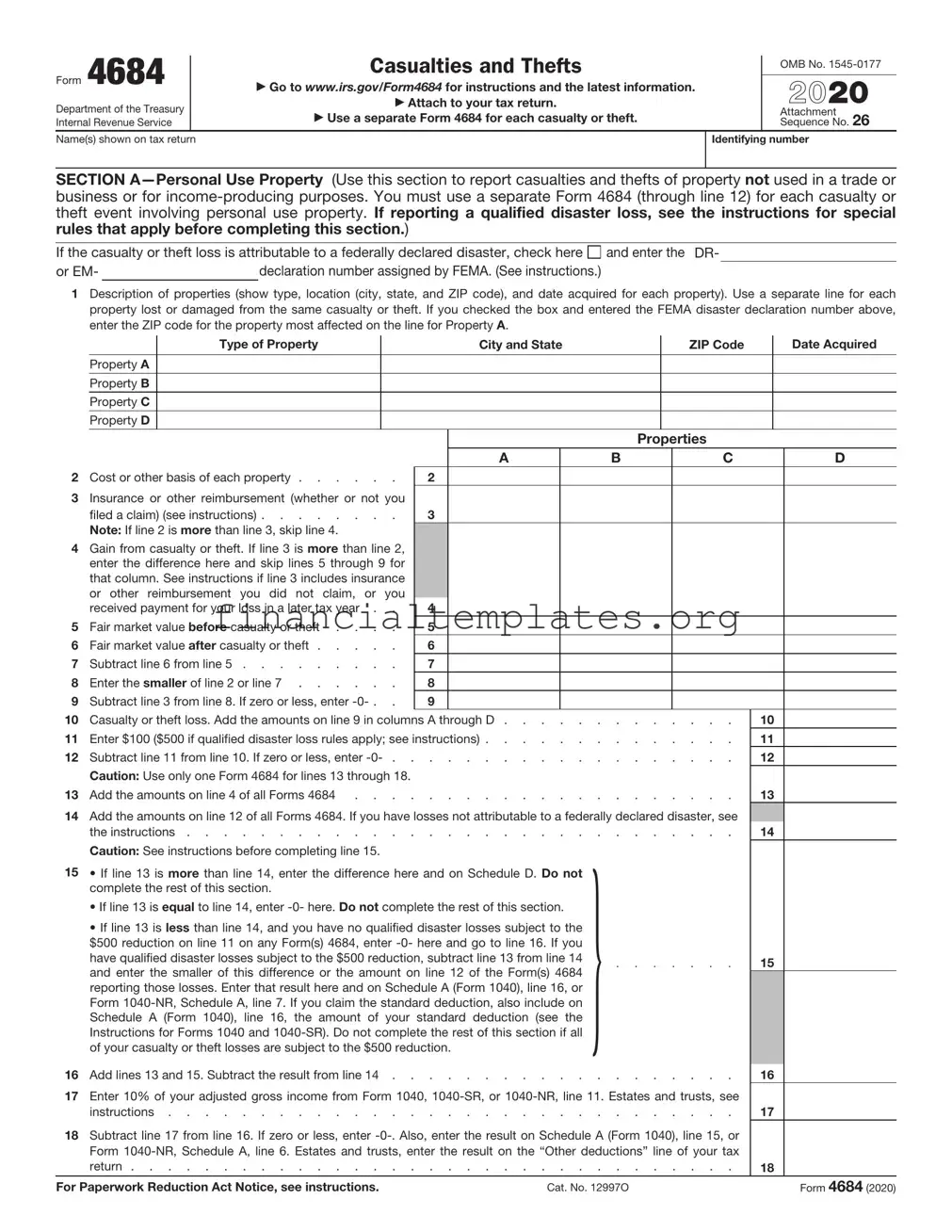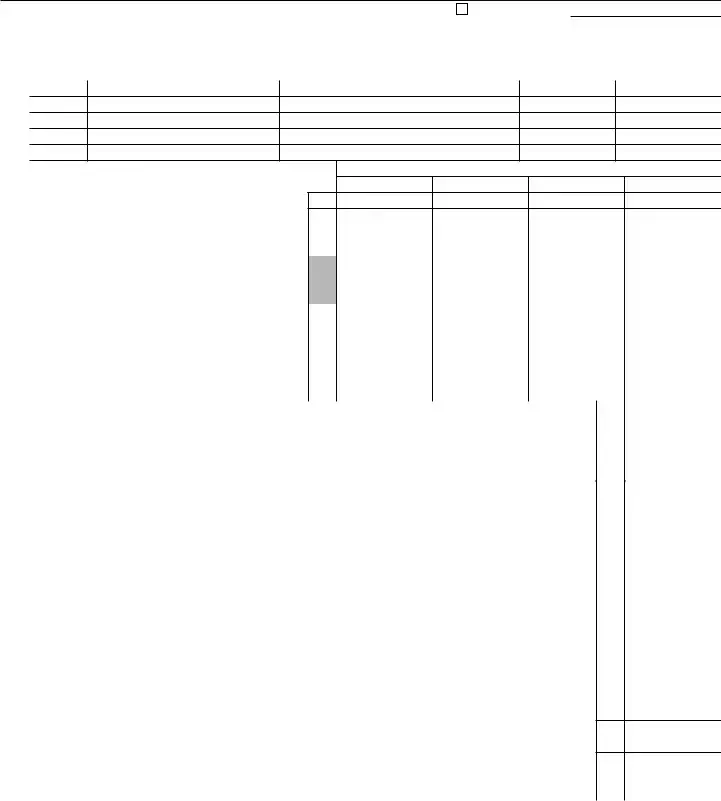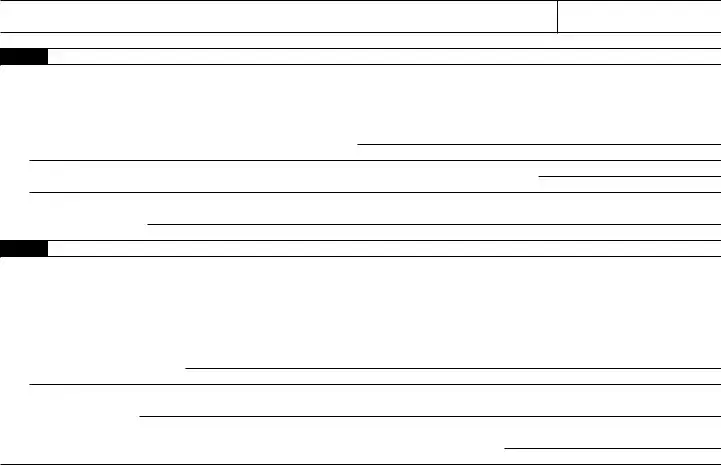Form 4684 |
|
Casualties and Thefts |
|
OMB No. 1545-0177 |
|
|
|
|
|
|
|
|
|
|
▶ Go to www.irs.gov/Form4684 for instructions and the latest information. |
|
2021 |
Department of the Treasury |
|
▶ Attach to your tax return. |
|
|
▶ Use a separate Form 4684 for each casualty or theft. |
|
Attachment |
Internal Revenue Service |
|
|
Sequence No. 26 |
Name(s) shown on tax return |
|
Identifying number |
|
|
|
|
|
SECTION A—Personal Use Property (Use this section to report casualties and thefts of property not used in a trade or business or for income-producing purposes. For tax years 2018 through 2025, if you are an individual, casualty or theft losses of personal-use property are deductible only if the loss is attributable to a federally declared disaster. You must use a separate Form 4684 (through line 12) for each casualty or theft event involving personal-use property. If reporting a qualified disaster loss, see the instructions for special rules that apply before completing this section.)
If the casualty or theft loss is attributable to a federally declared disaster, check here and enter the DR- |
|
or EM- |
|
declaration number assigned by FEMA. (See instructions.) |
|
|
|
|
1Description of properties (show type, location (city, state, and ZIP code), and date acquired for each property). Use a separate line for each property lost or damaged from the same casualty or theft. If you checked the box and entered the FEMA disaster declaration number above, enter the ZIP code for the property most affected on the line for Property A.
Type of Property |
City and State |
ZIP Code |
Date Acquired |
Property A
Property B
Property C
Property D
Properties
2 Cost or other basis of each property |
2 |
3Insurance or other reimbursement (whether or not you
filed a claim) (see instructions) |
3 |
Note: If line 2 is more than line 3, skip line 4. |
|
4Gain from casualty or theft. If line 3 is more than line 2, enter the difference here and skip lines 5 through 9 for that column. See instructions if line 3 includes insurance
|
or other reimbursement you did not claim, or you |
|
|
|
|
|
|
received payment for your loss in a later tax year . . |
|
4 |
|
|
|
|
5 |
Fair market value before casualty or theft . . . . |
|
5 |
|
|
|
|
6 |
Fair market value after casualty or theft |
|
6 |
|
|
|
|
7 |
Subtract line 6 from line 5 |
|
7 |
|
|
|
|
8 |
Enter the smaller of line 2 or line 7 |
|
8 |
|
|
|
|
9 |
Subtract line 3 from line 8. If zero or less, enter -0- . . |
|
9 |
|
|
|
|
10 |
Casualty or theft loss. Add the amounts on line 9 in columns A through D |
10 |
|
11 |
Enter $100 ($500 if qualified disaster loss rules apply; see instructions) |
11 |
|
12 |
Subtract line 11 from line 10. If zero or less, enter -0- . . |
. . . . . . . . . . . . . . . . . |
12 |
|
|
Caution: Use only one Form 4684 for lines 13 through 18. |
|
|
|
|
|
13 |
Add the amounts on line 4 of all Forms 4684 . . . . |
. . . . . . . . . . . . . . . . . |
13 |
|
14 |
Add the amounts on line 12 of all Forms 4684. If you have losses not attributable to a federally declared disaster, see |
|
|
|
the instructions |
. . . . . . . . . . . . . . . . . |
14 |
|
|
Caution: See instructions before completing line 15. |
|
} |
|
|
|
|
|
|
|
|
15 |
• If line 13 is more than line 14, enter the difference here and on Schedule D. Do not |
|
|
|
|
complete the rest of this section. |
|
|
|
|
|
• If line 13 is equal to line 14, enter -0- here. Do not complete the rest of this section. |
|
|
|
|
• If line 13 is less than line 14, and you have no qualified disaster losses subject to the |
|
|
|
|
$500 reduction on line 11 on any Form(s) 4684, enter -0- here and go to line 16. If you |
|
|
|
|
have qualified disaster losses subject to the $500 reduction, subtract line 13 from line 14 |
. . . . . . . |
15 |
|
|
and enter the smaller of this difference or the amount on line 12 of the Form(s) 4684 |
|
|
|
|
|
|
reporting those losses. Enter that result here and on Schedule A (Form 1040), line 16; or |
|
|
|
|
Schedule A (Form 1040-NR), line 7. If you claim the standard deduction, also include on |
|
|
|
|
Schedule A (Form 1040), line 16, the amount of your standard deduction (see the |
|
|
|
|
Instructions for Form 1040). Do not complete the rest of this section if all of your |
|
|
|
|
casualty or theft losses are subject to the $500 reduction. |
|
|
|
|
16 |
Add lines 13 and 15. Subtract the result from line 14 . . |
. . . . . . . . . . . . . . . . . |
16 |
|
17Enter 10% of your adjusted gross income from Form 1040, 1040-SR, or 1040-NR, line 11. Estates and trusts, see
18Subtract line 17 from line 16. If zero or less, enter -0-. Also, enter the result on Schedule A (Form 1040), line 15; or
Schedule A (Form 1040-NR), line 6. Estates and trusts, enter the result on the “Other deductions” line of your tax return |
18 |
For Paperwork Reduction Act Notice, see instructions. |
Cat. No. 12997O |
Form 4684 (2021) |

Form 4684 (2021) |
Attachment Sequence No. 26 |
Page 2 |
Name(s) shown on tax return. Do not enter name and identifying number if shown on other side. |
Identifying number |
SECTION B—Business and Income-Producing Property
Part I Casualty or Theft Gain or Loss (Use a separate Part l for each casualty or theft.)
19Description of properties (show type, location, and date acquired for each property). Use a separate line for each property lost or damaged from the same casualty or theft. See instructions if claiming a loss due to a Ponzi-type investment scheme and Section C is not completed.
Property A Property B Property C Property D
Properties
20 Cost or adjusted basis of each property |
20 |
21Insurance or other reimbursement (whether or not you
filed a claim). See the instructions for line 3 . . . . |
|
21 |
|
Note: If line 20 is more than line 21, skip line 22. |
|
|
|
|
|
|
22Gain from casualty or theft. If line 21 is more than line 20, enter the difference here and on line 29 or line 34, column (c), except as provided in the instructions for line 33. Also, skip lines 23
|
through 27 for that column. See the instructions for line 4 if line |
|
|
|
|
|
|
|
|
|
|
|
|
21 includes insurance or other reimbursement you did not |
|
|
|
|
|
|
|
|
|
|
|
|
claim, or you received payment for your loss in a later tax year |
|
22 |
|
|
|
|
|
|
|
|
|
|
23 |
Fair market value before casualty or theft . . . . |
|
23 |
|
|
|
|
|
|
|
|
|
|
24 |
Fair market value after casualty or theft |
|
24 |
|
|
|
|
|
|
|
|
|
|
25 |
Subtract line 24 from line 23 |
|
25 |
|
|
|
|
|
|
|
|
|
|
26 |
Enter the smaller of line 20 or line 25 |
|
26 |
|
|
|
|
|
|
|
|
|
|
|
Note: If the property was totally destroyed by casualty or |
|
|
|
|
|
|
|
|
|
|
|
|
lost from theft, enter on line 26 the amount from line 20. |
|
|
|
|
|
|
|
|
|
|
|
27 |
Subtract line 21 from line 26. If zero or less, enter -0- . |
|
27 |
|
|
|
|
|
|
|
|
|
|
28 |
Casualty or theft loss. Add the amounts on line 27. Enter the total here and on line 29 or line 34. See instructions . |
. |
|
28 |
|
|
Part II |
Summary of Gains and Losses (from separate Parts l) |
|
|
(b) Losses from casualties or thefts |
|
|
(c) Gains from |
|
|
|
|
|
|
|
|
(i) Trade, business, |
(ii) |
Income- |
|
|
casualties or thefts |
|
|
(a) Identify casualty or theft |
|
|
|
|
rental, or royalty |
|
|
includible in income |
|
|
|
|
|
|
producing property |
|
|
|
|
|
|
|
|
|
property |
|
|
|
|
|
|
|
|
Casualty or Theft of Property Held One Year or Less |
|
|
|
|
|
|
29 |
|
|
|
|
|
|
( |
) |
( |
|
|
|
) |
|
|
|
|
|
|
|
|
( |
) |
( |
|
|
|
) |
|
|
|
|
|
|
|
|
|
|
|
|
|
30 |
Totals. Add the amounts on line 29 |
. . . . . |
30 |
( |
) |
( |
|
|
|
) |
|
31Combine line 30, columns (b)(i) and (c). Enter the net gain or (loss) here and on Form 4797, line 14. If Form 4797 is
not otherwise required, see instructions . . . . . . . . . . . . . . . . . . . . . . .
32Enter the amount from line 30, column (b)(ii), here. Individuals, enter the amount from income-producing property on Schedule A (Form 1040), line 16; or Schedule A (Form 1040-NR), line 7. (Do not include any loss on property used as an employee.) Estates and trusts, partnerships, and S corporations, see instructions . . . . . . . . . .
Casualty or Theft of Property Held More Than One Year
33 |
|
Casualty or theft gains from Form 4797, line 32 |
33 |
|
34 |
|
|
|
( |
) |
( |
) |
|
|
|
|
|
( |
) |
( |
) |
|
|
|
|
|
|
|
|
|
|
35 |
|
Total losses. Add amounts on line 34, columns (b)(i) and (b)(ii) |
35 |
( |
) |
( |
) |
|
36 |
|
Total gains. Add lines 33 and 34, column (c) |
36 |
|
37 |
|
Add amounts on line 35, columns (b)(i) and (b)(ii) |
37 |
|
38 |
|
If the loss on line 37 is more than the gain on line 36: |
|
|
|
|
|
|
|
a Combine line 35, column (b)(i), and line 36, and enter the net gain or (loss) here. Partnerships and S corporations, see |
|
|
|
|
the Note below. All others, enter this amount on Form 4797, line 14. If Form 4797 is not otherwise required, see |
|
|
|
|
38a |
|
|
instructions |
|
b Enter the amount from line 35, column (b)(ii), here. Individuals, enter the amount from income-producing property on |
|
|
|
|
Schedule A (Form 1040), line 16; or Schedule A (Form 1040-NR), line 7. (Do not include any loss on property used as |
|
|
|
|
an employee.) Estates and trusts, enter on the “Other deductions” line of your tax return. Partnerships and S |
|
|
|
|
38b |
|
|
corporations, see the Note below |
39If the loss on line 37 is less than or equal to the gain on line 36, combine lines 36 and 37 and enter here. Partnerships,
see the Note below. All others, enter this amount on Form 4797, line 3 |
39 |
Note: Partnerships, enter the amount from line 38a, 38b, or 39 on Form 1065, Schedule K, line 11. |
|
S corporations, enter the amount from line 38a or 38b on Form 1120-S, Schedule K, line 10. |
|
Form 4684 (2021)
Form 4684 (2021) |
Attachment Sequence No. 26 |
Page 3 |
Name(s) shown on tax return |
|
Identifying number |
SECTION C—Theft Loss Deduction for Ponzi-Type Investment Scheme Using the Procedures in Revenue Procedure 2009-20 (Complete this section in lieu of Appendix A in Revenue Procedure 2009-20. See instructions.)
|
|
|
|
|
|
|
Part I |
Computation of Deduction |
|
|
|
40 |
Initial investment |
40 |
|
|
41 |
Subsequent investments (see instructions) |
41 |
|
|
42 |
Income reported on your tax returns for tax years prior to the discovery year |
|
|
|
|
(see instructions) |
. . . . . . . . . . . . . . . . . . . . . . |
42 |
|
|
43 |
Add lines 40, 41, and 42 |
43 |
|
|
44 |
Withdrawals for all years (see instructions) |
44 |
|
|
45 |
Subtract line 44 from line 43. This is your total qualified investment |
45 |
|
|
46 |
Enter 0.95 (95%) if you have no potential third-party recovery. Enter 0.75 (75%) if you have |
|
|
|
|
potential third-party recovery |
46 |
. |
|
47 |
Multiply line 46 by line 45 |
47 |
|
|
48 |
Actual recovery |
48 |
|
|
49 |
Potential insurance/Securities Investor Protection Corporation (SIPC) recovery . . . . |
49 |
|
|
50 |
Add lines 48 and 49. This is your total recovery |
50 |
|
|
51 |
Subtract line 50 from line 47. This is your deductible theft loss. Include this amount on line |
|
|
|
|
28 of Section B, Part I. Do not complete lines 19–27 for this loss. Then complete Section B, |
|
|
|
|
Part II |
51 |
|
|
Part II |
Required Statements and Declarations (See instructions.) |
|
|
|
•I am claiming a theft loss deduction pursuant to Revenue Procedure 2009-20 from a specified fraudulent arrangement conducted by the following individual or entity.
Name of individual or entity
Taxpayer identification number (if known) Address
•I have written documentation to support the amounts reported in Part I of this Section C.
•I am a qualified investor, as defined in section 4.03 of Revenue Procedure 2009-20.
•If I have determined the amount of my theft loss deduction using 0.95 on line 46 above, I declare that I have not pursued and do not intend to pursue any potential third-party recovery, as that term is defined in section 4.10 of Revenue Procedure 2009-20.
•I agree to comply with the conditions and agreements set forth in Revenue Procedure 2009-20 and this Section C.
•If I have already filed a return or amended return that does not satisfy the conditions in section 6.02 of Revenue Procedure 2009-20, I agree to all adjustments or actions that are necessary to comply with those conditions. The tax year(s) for which I filed the return(s) or amended return(s) and the date(s) on which they were filed are as follows:
Form 4684 (2021)
Form 4684 (2021) |
Attachment Sequence No. 26 |
Page 4 |
Name(s) shown on tax return |
|
Identifying number |
SECTION D—Election To Deduct Federally Declared Disaster Loss in Preceding Tax Year (See instructions.)
Part I Election Statement
By providing all of the information below, the taxpayer elects, under section 165(i) of the Internal Revenue Code, to deduct a loss attributable to a federally declared disaster and that occurred in a federally declared disaster area in the tax year immediately preceding the tax year the loss was sustained.
Attach this Section D to your return or amended return for the tax year immediately preceding the tax year the loss was sustained to claim the disaster loss deduction.
52Provide the name or a description of the federally declared disaster.
53Provide the date or dates (mm/dd/yyyy) of the loss or losses attributable to the federally declared disaster.
54Specify the address, including the city or town, county or parish, state, and ZIP code where the damaged or destroyed property was located at the time of the disaster.
Part II Revocation of Prior Election
By providing all of the information below, the taxpayer revokes the prior election under section 165(i) of the Internal Revenue Code to deduct a loss attributable to a federally declared disaster and that occurred in a federally declared disaster area in the tax year immediately preceding the tax year the loss was sustained.
Attach this Section D to your amended return for the tax year immediately preceding the tax year the loss was sustained to remove the previous disaster loss deduction.
55Provide the name or a description of the federally declared disaster and the address of the property that was damaged or destroyed and for which the election was claimed.
56Specify the date (mm/dd/yyyy) you filed the prior election, which you are now revoking. (See instructions and note that new rules went into effect on October 13, 2016.)
57Enclose your payment or otherwise provide evidence for, or explanation of, your arrangements for the repayment of the amount of any credit or refund which you received and which resulted from the prior election (which you are now revoking).
Form 4684 (2021)




